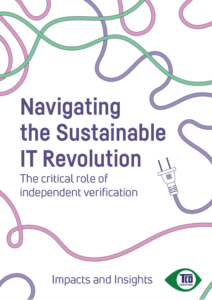Procurement teams are increasingly responsible for ensuring product compliance with relevant regulations and their organization’s sustainability policies. Both senior management and stakeholders expect sustainable IT procurement to be verifiable, measurable, and backed by evidence.
Private and public sector organizations with sustainability goals are being held to a higher standard of proof, and procurement is no exception. Therefore, lowering the risk for false claims, greenwash and bluewash is essential.
Purchasers have long been asked to rely on self declarations, but new standards for transparency and accountability are forcing them to go deeper. New procurement guidelines, internal targets from management, and expectations from stakeholders all add up to increased responsibility for accurate impact reporting connected to procurement. This means balancing several priorities at once: cost reductions, product performance, supplier assessments, social impacts, reparability, upgradability, and reusability are some examples.
The risk associated with relying on unverified sustainability claims is real. In some cases, we have observed that factories declaring a 60 hour work-week have in fact shown to have working hours well above 80 hours. In other cases, audits in factories claiming to provide adequate emergency exits, reveal some exits are locked or blocked. We’ve also discovered inaccurate battery life information stated in product specifications for notebook computers. When subject to independent tests, the capacity has been shown to be significantly lower than what the brand owner declares. Clearly, when a purchaser is asked to trust these claims and declarations, the risks are significant, and may impact both the organization’s brand and bottom line.
In IT procurement, this means that suppliers must also have proven high social and environmental standards connected to the sourced product. Stakeholders demand assurance that purchases do not contribute to labor law violations in the supply chain, such as child labor, or negative environmental impacts. IT procurement organizations today are expected to be strategic and prove that they promote sustainability and mitigate risks.
Jonathan Rivin, Materials Evaluation Specialist, at the Oregon Department of Environmental Quality, explains the importance of strategic IT procurement for the State of Oregon.
“IT purchases are one of the largest categories of state, local government, and public institutional spending. Therefore, supply chain impacts can be significant and affect later stages of the life cycle. Improving sustainability practices along the supply chain reduces the potential for supply chain disruption and increases resiliency,” he says.
“Improving sustainability practices along the supply chain reduces the potential for supply chain disruption and increases resiliency”
New regulations also hold the purchaser responsible for making sure that products are verified to comply with the criteria set in procurement. Increasingly, purchasers are expected to ask for proof of compliance to account for the sustainability claims connected to the products sourced, along with the supply chains where they are made. Current examples include the EU Green Public Procurement Criteria, and the emergence of Modern Day Slavery legislation, such as in Australia and the UK. In addition, procurement needs to ensure they are promoting fair competition among bidders, by making selection criteria clear.
Felice Alfieri is Policy Officer at the European Commission. He works with EU Green Public Procurement criteria (EU GPP) and stresses the importance of verification that purchasers need to address.
“EU Green Public Procurement criteria are written to ensure that environmental performance claims are verifiable, auditable, and comparable,” says Felice Alfieri.

Another important factor for procurement teams is non-financial reporting, such as ESG (Environmental, Social, Governance) reporting. Inaccurate or unverified ESG reporting increases reputational and brand risks that can damage relations to stakeholders, investors, customers and employees. Being exposed as a purchaser that does not take sustainability seriously costs.
It all comes down to proof. Even the strictest sustainability criteria fall flat if there is no system in place to independently verify and monitor sustainability progress. For procurement, a solution to avoid greenwashing is to demand independent verification of claims and proof of compliance. Specifying ecolabels that have all these systems in place is a good place to start.





